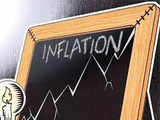A quick and easy way to know everything on current issues. Get 360-degree takes on trending news that tell you all about the issue at one place at Economic Times
ET Explains

ET Explainer: Why the rupee was most stable emerging market currency
The Indian rupee remained stable in 2023 due to the narrowing current account deficit and strong economic fundamentals. The rupee's performance was positive, and its strength is attributed to sound economic fundamentals and the moderation of the current account deficit.

ET Explainer: What trend is the falling unemployment rate hiding?
The urban unemployment rate declined to its lowest level in over four years in Q3FY24. But instead of cheers, it has raised concerns.

ET Explainer: How title insurance can help change realty landscape
Title insurance benefits homebuyers with clear ownership and lenders with secure investments. It potentially lowers interest rates and improves access to financing. Investors also benefit from reduced risk exposure in Indian real estate.

ET Explains: What is ASI, and what is its connection with GDP?
India swiftly recovered from the Covid-19 pandemic, with employment rising above pre-pandemic levels in 2021-22, according to the latest Annual Survey of Industries (ASI). Investment growth also picked up during this period. The ASI measures industrial statistics of registered manufacturing enterprises and provides data on gross value added, output, inputs, invested capital, net income, and profits. The 2021-22 results indicated a sharp recovery in employment, with 17.2 million people employed by enterprises during the fiscal year. The ASI data helps determine the industrial sector's contribution to GDP.

ET Explains: Why the fate of the US H-1B visa regime hangs in the balance
US elections impact visa regime, including H-1B visas for skilled foreign workers. 85,000 visas issued via lottery, majority held by Indians. Trump opposes immigration, plans domestic deportation. Proposed rule to require H-1B petitions from IT and professional services companies. Online filing for H-1B visas for fiscal year 2025 is set to begin in February, with filing of petitions for selected registrants likely to begin in April. Indians hold the majority of H-1B visas.

Will US elections ring in change in the visa regime for Indians?
US politicians are discussing changes to the H-1B visa regime as immigration becomes a major issue in the upcoming November election. Republican frontrunner Donald Trump has expressed anti-immigration sentiments, while President Joe Biden proposes more flexible rules. Tech companies will be impacted by the changes, including fee hikes and stricter eligibility requirements.

Apple app ecosystem changes in Europe: Why app developers are unhappy?
Apple announces changes to Apple Store and iOS in response to EU regulations. Users in EU can download apps and make purchases outside App Store. Developers can distribute apps via alternate stores and opt out of in-app payment system. New fee structures introduced, including a 17% commission for apps using alternate payment system. 'Core technology fee' charges ₹0.50 per annual app install for popular apps. App developers criticize changes. India investigation may lead to similar changes.

ET Explainer: Land records digitisation to aid effective policy making
The government's move to digitise land records is set to transform the country's age-old land management system. This initiative, under the 'Digital India' programme, involves conversion of paper-based records into electronic formats. More than 94% of rights records and state-specific registration offices have already been digitised under the 'Digital India Land Records Modernization Programme'. Digitisation of land records holds immense significance, as it has the potential to enhance transparency in land-related transactions, reduce property ownership disputes and make land management efficient. The government has been proactive in promoting digitisation of land records. Initiatives such as the National Land Records Modernisation Programme and the Digital India Land Records Modernisation Programme have been pivotal in driving this process.

Here's what is keeping rice on the boil
Some of the key reasons for rice inflation include consistent increase in the minimum support price (MSP), government procurement of rice above MSP to fulfil poll promises, possibility of a decline in India's kharif rice production by about 4% due to the impact of El Nino on the monsoons, and strong demand from poultry and ethanol industry.

Dissecting inflation to find what's core and non-core
Core inflation is the change in the costs of goods and services excluding the price variations in seasonal elements, such as those related to food and energy. Core inflation represents the long-term trend in the price level. Monetary policy measures are known to impact core inflation levels more than non-core or food inflation and hence considered a gauge for the success of monetary policy measures.
Must Watch

ET Explains: Difference between core and non-core inflation in India
Core inflation represents the long-term trend in the price level and is impacted by monetary policy measures. On the other hand, non-core inflation is driven by supply side factors such as food and fuel prices, and monetary policy measures have limited impact on it. Both core and non-core inflation contribute to headline inflation.

Everything you need to know about the Draft Indian Stamp Bill, 2023
The Centre has released a draft of the proposed Indian Stamp Bill, 2023, to replace the outdated India Stamp Act, 1899. The draft bill introduces provisions for digital e-stamping and aims to modernize the stamp duty regime. It proposes changes such as incorporating digital signatures, a framework for digital records, and an expanded definition of financial instruments.

Understanding no-cost EMI and its implications
No Cost EMI, also known as zero cost EMI or interest-free EMI, is a financing option where the cost of a product can be converted into Equated Monthly Installments (EMIs) without incurring additional charges beyond the agreed purchase price. It's widely available at various online and offline stores.

What's next for Zee Entertainment, promoter family, and Punit Goenka
Zee Entertainment Enterprises CEO & MD Punit Goenka and the promoter family can continue to call the shots with a tiny equity stake. Financial institutions may wait for Goenka to find a 'white knight' and for Sebi's final report and court decision. Depromoterisation is voluntary, but the promoters and CEO of Zee want to continue. Shareholders rarely push for change due to a lack of activism in the corporate landscape.

ET Explains: What drives consumer inflation?
Inflation in India rose to 5.7% in December, despite most categories experiencing an easing of inflation. Core inflation fell to its lowest level in 48 months, while the food index rose to its highest level in four months. The analysis of inflation is based on data from 1,114 urban markets and 1,181 villages, collected through personal visits by field staff.

ET Explainer: How to avoid falling into a credit card trap
Credit cards can be used to pay bills and for shopping both online and offline provided the total payment is within the credit limit provided by the issuer. Credit card issuers offer interest-free credit periods ranging from 20 to 50 days. It is typically the period between the date of your purchase and the next payment due date.
